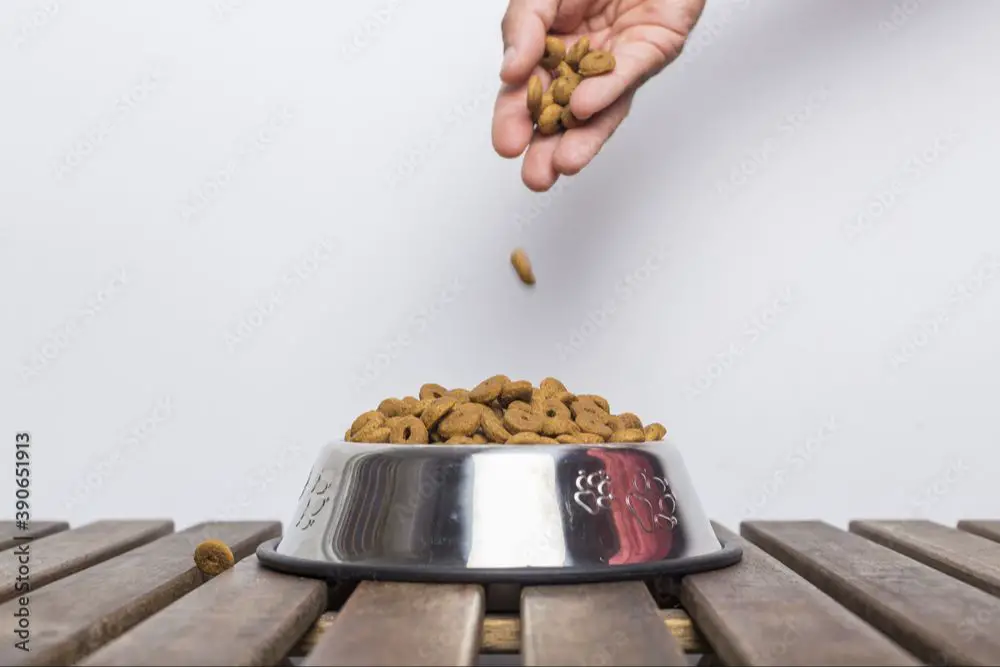Introduction
Dry dog food, sometimes called kibble, is a popular and convenient way to feed our canine companions. This easily-stored type of dog food comes in a range of flavors, sizes and formulas catered to dogs’ nutritional needs. But is dry food the best option for your pup? In this article, we’ll examine the pros and cons of feeding dogs a dry kibble diet to help you make an informed decision.
Pros of Dry Dog Food
Dry dog food offers several advantages that make it a convenient and popular choice for many pet owners. Some of the main pros of dry dog food include:
Convenience

Dry kibble can be left out in a bowl for dogs to graze on throughout the day. This allows flexibility if owners have variable schedules or are away from home for periods of time. Dry food does not require refrigeration like canned food.
Dental Health
The crunchy texture of dry dog food helps clean dogs’ teeth and reduce plaque and tartar as they chew. This provides some dental benefits over wet food alternatives.
Cost-Effective
Dry dog food tends to be significantly cheaper per ounce than wet food. The bulk bags last a long time, making dry food more economical, especially for owners with larger dogs or multiple pets.
Easy to Measure Portions
Dry kibble can easily be scooped out and measured into precise portion sizes. This helps owners control and monitor their dog’s caloric intake.
Less Spoilage
An open bag of dry dog food can be stored for weeks without spoiling. Wet foods have a much shorter shelf life once opened and must be refrigerated. Dry foods reduce food waste.
Cons of Dry Dog Food

While dry dog food offers convenience and other benefits, there are some potential downsides to be aware of:
Less moisture
One of the main cons of dry dog food is that it contains much less moisture than wet food or a fresh diet. Dry food only contains around 10% moisture, whereas canned food contains around 75% moisture. Some dogs, especially those prone to urinary crystals or stones, may not get enough water when eating only dry food. Make sure to encourage your dog to drink plenty of water.
Potential for dental issues
The crunchy texture of dry food helps clean plaque off teeth as the dog chews. However, some dental experts believe dry food may sometimes shatter or break into small pieces that stick to teeth. This could potentially contribute to tartar buildup. Consider adding some dental chews or brushing to your dog’s routine.
Less palatable
Dogs generally seem to find wet and fresh food more appealing and palatable than dry kibble. Some picky eaters may reject dry food or eat less. Adding warm water or low sodium broth may enhance flavor and aroma.
More preservatives
The dry kibble format requires more preservatives to prevent spoilage compared to canned or homemade options. Some dogs may have sensitivities to common preservatives like BHA or BHT. Watch for signs of irritation or allergies.
Ingredients in Dry Dog Food

Dry dog food contains a variety of ingredients that provide nutritional value. Here are some of the main ingredients found in most dry dog foods:
Meat
Meat is the primary ingredient in most dry dog foods. Meat provides protein, which is essential for building muscle and body tissues. Common meats used include chicken, beef, turkey, lamb, and fish.
Grains
Grains like corn, wheat, rice, barley, and oats are inexpensive sources of carbohydrates, calories, and fiber. They help bind the food into kibble shapes. However, dogs have a harder time digesting grains than meat proteins.
Vegetables
Vegetables like potatoes, peas, and sweet potatoes are included for additional vitamins, minerals, and fiber. They also add texture and flavor variety.
Vitamins & Minerals
Dry dog foods contain added vitamins and minerals to ensure they provide complete and balanced nutrition. Common additions are calcium, phosphorus, potassium, sodium, zinc, iron, vitamin A, vitamin D, and vitamin E.
Preservatives
Since dry dog food contains only around 10% moisture, preservatives are added to prevent spoilage and mold growth. Common preservatives include BHA, BHT, ethoxyquin, and vitamin E.
Types of Dry Dog Food
There are a few main types of dry dog food to consider:
Kibble
Kibble is the most common type of dry dog food. Kibble consists of dough that is cooked and extruded into small pieces. The cooking process helps to kill bacteria and extends the shelf life. Kibble comes in a variety of shapes, sizes, textures, and flavors. Most kibble is made from a combination of meat meals, grains, vegetables, and nutrients.
Dehydrated
Dehydrated dog food is made by taking raw foods like meat, fruits, and vegetables and removing the water content. This helps preserve the foods while retaining more nutrients than kibble. Dehydrated foods need to be rehydrated before feeding by adding warm water and allowing time for the food to rehydrate. Some brands require refrigeration after rehydrating.
Prescription

Prescription dry dog foods are formulated to help with specific health conditions. For example, some prescription diets are made for dogs with kidney disease, liver disease, food allergies, or other issues. Prescription diets have nutrients tailored to support the dog’s needs. Veterinarians usually recommend and provide prescription dog food.
Transitioning to Dry Food
When transitioning your dog to dry food, it’s important to do so gradually to avoid digestive upset. Abruptly changing your dog’s diet can lead to diarrhea, vomiting, and overall stomach distress. Here are some tips for slowly transitioning to dry dog food:
Mix the new dry food with your dog’s old food, starting with 25% new and 75% old. Slowly increase the ratio of new to old food over a period of 7-10 days. For example:
- Days 1-3: 25% new food, 75% old food
- Days 4-6: 50% new food, 50% old food
- Days 7-10: 75% new food, 25% old food
Keep an eye out for any digestive upset like loose stool, gas, or vomiting. If you notice any issues, slow the transition down by keeping the ratio of new to old food the same for a few extra days before increasing the new food.
Transition gradually over a week or more when bringing an adult dog onto dry food. Puppies can transition faster over 3-5 days since their digestive systems adapt quicker.
Feed smaller, more frequent meals during the transition to prevent stomach overload. Stick to scheduled mealtimes rather than free-feeding.
Make sure your dog has plenty of fresh water available at all times when feeding dry food. The kibble’s low moisture content can lead to dehydration.
A gradual transition gives your dog’s digestive system time to adapt to the new food. Watching for signs of trouble and slowing things down if needed helps avoid adverse reactions.
How Much to Feed
How much dry dog food you should feed your dog depends on several factors including their size, age, and activity level. It’s important to follow the feeding guidelines on the dog food label which provides recommended amounts based on your dog’s weight. Puppies often need more food per pound of body weight than adult dogs. Senior dogs may need less food if they are less active. Dogs who get a lot of exercise or are very active may need more food than couch potato dogs. The feeding guidelines are just a starting point, so monitor your dog’s weight and body condition and adjust as needed. If they start gaining or losing weight, you may need to feed a little more or less. It’s generally best to follow the label instructions for amount and frequency of feeding based on your individual dog’s needs.
Storage Tips
Proper storage is crucial to maintaining the freshness and nutritional value of dry dog food. Here are some tips for storing dry dog food:
- Store in a cool, dry place – Heat and humidity can cause dry dog food to lose its freshness and become stale. Find a place in your home that maintains a relatively cool, consistent temperature away from direct sunlight.
- Use an airtight container – Pour the dry food into an airtight plastic, glass or metal container, which helps prevent insect infestations and keeps moisture out. Storing in the original bag is not ideal since bags are easily torn and allow air inside.
- Never store directly on floor – Choose a shelf or storage bin elevated off the floor, since floors tend to be more humid and attract pests.
- Avoid temperature fluctuations – Don’t place the container right next to heating and cooling vents that dramatically shift temperatures.
- Check expiration date – Write the expiration or best-by date on a sticky note on the storage container as a reminder.
- Clean container regularly – Wash plastic or glass containers with soap and water, especially before pouring a new bag of food. Replace damaged containers.
Following proper dry food storage guidelines will help maintain the quality and prolong the shelf life. Always keep the food fresh and safe for your dog to enjoy.
Homemade vs. Store-Bought
Some dog owners opt to make their dog’s food at home rather than buying commercial dry food. There are a few potential benefits as well as drawbacks to consider when deciding between homemade and store-bought dry dog food.
Homemade dog food allows you to control exactly what ingredients go into your dog’s meals. You can select high-quality whole foods and customize recipes to your dog’s nutritional needs. However, formulating balanced homemade meals takes research and planning. It’s important to consult a veterinarian or canine nutritionist to ensure homemade meals contain complete and balanced nutrition.
Store-bought dry dog foods provide balanced nutrition in an easy, convenient form. Reputable brands conduct extensive testing to formulate kibble that provides complete nutrition. However, some lower-quality brands may contain artificial preservatives, colors, and fillers. Reading labels carefully is important when choosing a commercial brand.
In the end, both homemade and quality store-bought dry foods can be healthy options for dogs. Homemade takes more work but provides control over ingredients. Store-bought offers convenience if you choose a brand meeting high nutritional standards. Consider your dog’s needs and your own time when deciding between these two approaches.
Conclusion
In summary, dry dog food has several advantages over wet food such as dental health, convenience, and lower cost. However, it also has some drawbacks to consider such as the potential for dehydration, possible nutritional deficiencies, and less palatability for picky eaters.
When choosing a dry dog food, look for a high-quality brand that contains quality ingredients like meat, whole grains, veggies, and fruit. Avoid fillers, by-products, and artificial preservatives. Consider your dog’s age, activity level, and any health conditions when selecting a formula.
To transition to dry food, mix increasing amounts with your dog’s current wet food over 7-10 days. Monitor their water intake and energy levels. Stick to the recommended feeding guidelines and store dry food properly in an airtight container.
While homemade diets allow for more customization, dry kibble provides a nutritionally balanced and convenient option for most dogs. Focus on choosing a premium brand your dog enjoys and feed the appropriate amount for their needs.